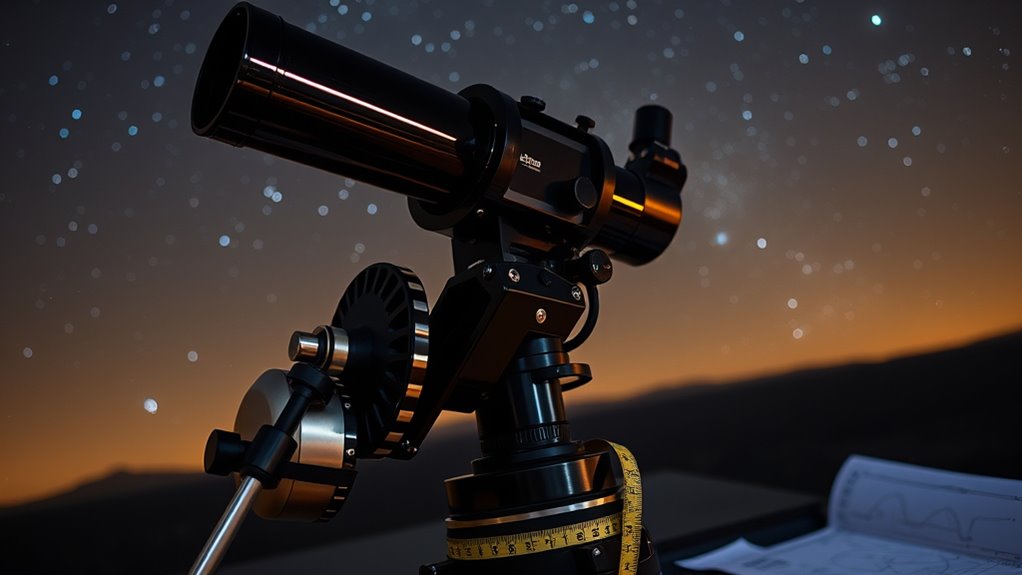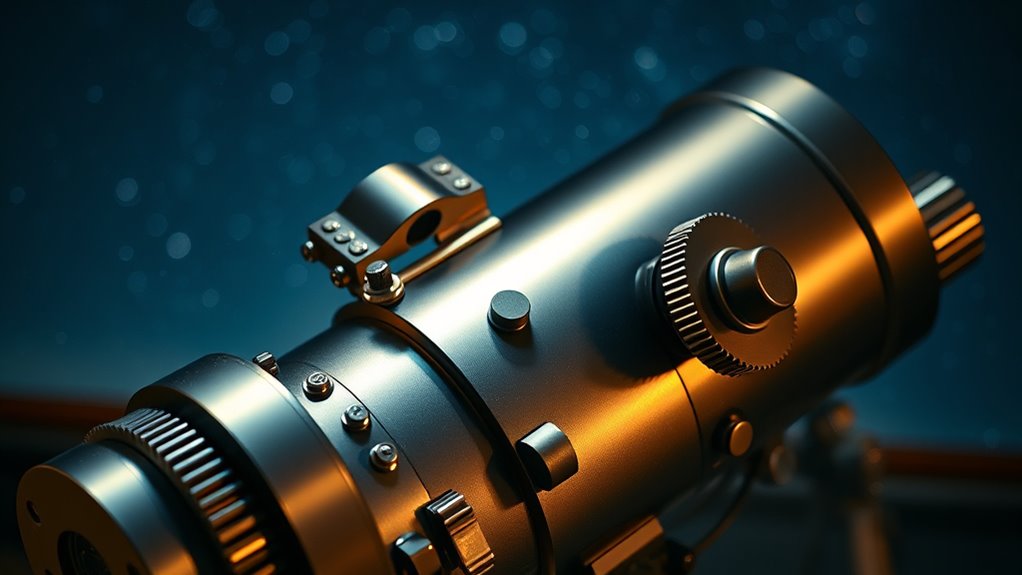If you’re looking for the best equatorial mount with a belt drive system, I highly recommend the iEXOS-100-2 PMC-Eight Tracker System. It balances portability and stability, making it perfect for astrophotography. With precise movements, great tracking accuracy, and easy setup, it’s an effective entry-level option. Plus, it integrates with the ExploreStars app for a smoother experience. Keep exploring, and you’ll discover more features that make this mount a standout choice for stargazers.
Key Takeaways
- The iEXOS-100-2 PMC-Eight Tracker System offers excellent portability and stability, weighing only 20 pounds.
- Its dual-axis worm gears and quiet stepper motor ensure precise movements for accurate astrophotography.
- With guiding performance of up to 6 minutes, it minimizes star trails, ideal for long-exposure imaging.
- The ExploreStars app simplifies star alignment and navigation, enhancing user experience and ease of setup.
- Entry-level pricing around $700 makes it an effective choice for beginners in astrophotography.
iEXOS-100-2 PMC-Eight Equatorial Tracker System for Astrophotography
If you’re an astrophotography enthusiast looking for an affordable yet capable equatorial mount, the iEXOS-100-2 PMC-Eight Tracker System might just be what you need. Weighing 20 pounds, it’s portable and built for stability. The dual-axis worm gears and quiet stepper motor guarantee precise movements, while the ExploreStars app simplifies star alignment and navigation. Users rave about its guiding performance, achieving exposures of up to 6 minutes with minimal star trails. Although it has some limitations, like initial GoTo inaccuracy and a flimsy tripod, with a few tweaks, it becomes an excellent entry-level choice for budding astrophotographers.
Best For: Astrophotography enthusiasts seeking an affordable and portable equatorial mount with decent performance for beginner setups.
Pros:
- Easy assembly and good stability, making it suitable for novice users.
- Capable guiding performance with exposures up to 6 minutes and minimal star trails.
- Intuitive operation via the ExploreStars app simplifies navigation and celestial object identification.
Cons:
- Initial GoTo system may require calibration to improve accuracy.
- Tripod legs are considered flimsy, impacting overall stability.
- Some users experience connectivity issues with firmware and control software, requiring additional troubleshooting.
Factors to Consider When Choosing Equatorial Mounts With Belt Drive Systems

When I’m selecting an equatorial mount with a belt drive system, I always consider several key factors. The payload capacity, tracking accuracy, and ease of setup are essential for my needs. Plus, I can’t overlook build quality and portability features, as they greatly impact my overall experience.
Payload Capacity
Understanding the payload capacity of an equatorial mount is essential for anyone serious about astrophotography. This capacity determines how much weight your equipment can safely support without compromising stability. If you exceed the recommended limits, you risk mechanical strain, reduced precision, and even damage to the belt drive system. I’ve found that mounts with higher payload ratings often come with reinforced belts and stronger motors, making them more capable of handling heavier loads. It’s vital to assess your total gear, including guide scopes and cameras, to avoid overburdening the mount. Selecting a mount with the right payload capacity not only enhances tracking stability but also minimizes vibrations during those long exposure sessions you’ll want for stunning astrophotography results.
Tracking Accuracy
While many factors contribute to the effectiveness of an equatorial mount, tracking accuracy stands out as a critical element for serious astrophotographers. High tracking accuracy, typically around 1 to 2 arcseconds in belt drive systems, allows for precise astrophotography. I’ve found that these systems significantly reduce backlash and gear slop, enhancing the mount’s ability to keep celestial objects in view during long exposures. Key components like well-tensioned belts and precision pulleys minimize periodic error, ensuring consistent tracking. It’s also essential to consider the mount’s stability and the quality of encoders and stepper motors. Regular calibration and periodic error corrections are essential to maintain ideal tracking accuracy, making these factors vital in my decision-making process.
Ease of Setup
Choosing an equatorial mount with a belt drive system can greatly simplify your setup process, especially if you’re enthusiastic to start observing or capturing images. With smoother movement and reduced backlash, these mounts make initial alignment much easier. I love that belt drive systems typically require fewer tension adjustments, allowing me to save time and focus on my observations. Many models even come with integrated polar alignment aids, which further reduce setup complexity. Plus, the quiet operation is a huge bonus, making adjustments comfortable in noise-sensitive areas. If you’re planning on using your mount in the field, the lightweight construction and straightforward assembly are perfect for quick setups. Overall, these features make the setup process enjoyable and efficient.
Build Quality
After experiencing the ease of setup with a belt drive equatorial mount, the next important factor I consider is build quality. High build quality guarantees durability and reliable performance, even under various observational conditions. I look for mounts made from premium materials like anodized aluminum and high-grade steel, as these reduce flexure and enhance stability during tracking. Well-constructed mounts feature precise machining and tight tolerances, which are essential for smooth, backlash-free operation. The robustness of the mount’s frame and gear components directly affects tracking accuracy and consistency. Ultimately, superior build quality minimizes vibrations and noise during slewing, resulting in clearer astrophotographs. When I invest in a mount, I want something that’s built to last and perform exceptionally.
Portability Features
When it comes to selecting an equatorial mount with a belt drive system, portability is a key consideration for me. I always look for lightweight and compact designs that make transport and setup a breeze. Foldable or removable tripod legs are a game changer, allowing me to reduce size and pack easily for trips. Battery-powered operation and compatibility with portable power sources enhance my mobility, freeing me from relying on external outlets. Quick assembly features save me valuable time, especially when I need to deploy my mount rapidly. Ultimately, materials like aluminum and carbon fiber strike an excellent balance between durability and weight reduction, ensuring I don’t sacrifice stability for portability. These factors help me enjoy stargazing wherever I go.
Control Options
While evaluating equatorial mounts with belt drive systems, I find control options to be a fundamental factor that can markedly enhance my stargazing experience. I appreciate wired hand controllers for their reliability, but I’m increasingly drawn to mounts that offer WiFi and Bluetooth connectivity. This allows me to control the mount remotely using my tablet or smartphone, making star alignment much easier. I also look for compatibility with open-source or third-party software, which lets me customize tracking and slewing to suit my needs. A reliable control system with precise timing is essential for astrophotography. Lastly, I pay attention to firmware updates, as they guarantee compatibility and introduce new features, keeping my mount performing at its best.
Software Compatibility
How can I guarantee that my equatorial mount with a belt drive system works flawlessly with my astrophotography gear? Software compatibility is key. I always check if the mount supports popular planetarium and control software like ASCOM or INDI. These options make my setup easier to use and enhance feature access. I also look for compatibility with mobile apps for Android, iOS, or Windows tablets, which allows me to operate my gear remotely. Keeping firmware updated is essential too, as it ensures compatibility with new software versions and fixes any bugs. Ultimately, I prefer open-source or open-architecture systems, which offer greater flexibility for customization and integration, making my astrophotography experience even smoother.
Price Range
What should you consider when evaluating the price range of equatorial mounts with belt drive systems? First, know that these mounts typically vary from around $300 for budget models to over $2,000 for high-end options. If you’re just starting, entry-level mounts priced between $300 and $700 are suitable for basic astrophotography. Moving up, mid-range systems, between $700 and $1,200, often provide better precision and stability. For serious astrophotographers, high-end mounts costing $1,200 and above offer superior tracking accuracy and advanced features. Remember, the price usually reflects build quality, motor precision, and included accessories. So, think carefully about what features you need to ensure you get the best value for your investment.
Frequently Asked Questions
What Is a Belt Drive System in Equatorial Mounts?
A belt drive system in equatorial mounts uses belts and pulleys to transfer motion from the motor to the telescope. I find this system incredibly efficient because it minimizes backlash, allowing for smoother tracking of celestial objects. This setup reduces wear and tear compared to traditional gear systems, making it ideal for astrophotography. When I use a belt drive mount, I appreciate the quiet operation and precise movements it offers during my stargazing sessions.
How Do I Maintain My Equatorial Mount?
I’ve learned that maintaining my equatorial mount is essential for peak performance. First, I regularly check for any loose screws or bolts, ensuring everything is secure. I also clean the gears and lubricate them as needed, which keeps the movement smooth. Additionally, I balance my telescope properly to reduce strain. Finally, I always store it in a dry, safe place to prevent damage. Trust me; these steps make a world of difference!
Can I Use My Mount for Visual Observation?
Absolutely, you can use your mount for visual observation! I’ve done it many times, and it works wonderfully. Just make sure you balance your telescope properly and check the alignment. The smooth tracking of a belt drive system enhances the experience, allowing you to enjoy the night sky without constant adjustments. I love how it makes viewing easier, letting me focus on the celestial wonders rather than the equipment.
What Is the Weight Limit for the Recommended Mounts?
Imagine a sturdy bridge, built to bear the weight of travelers. The recommended mounts typically support around 30 to 50 pounds, ensuring a safe journey for both your telescope and your observations. While I’ve found that each mount varies slightly, it’s vital to stay within these limits to avoid wobbling or misalignment. So, as you set out on your stargazing adventure, choose wisely and let your curiosity soar without heavy burdens.
Are There Any Alternatives to Belt Drive Systems?
Absolutely, there are alternatives to belt drive systems! I’ve explored several options, like gear-driven mounts and direct drive systems. Gear-driven mounts often provide precise tracking but can be a bit noisier. On the other hand, direct drive systems eliminate gears altogether, offering smooth movement and less maintenance. Each type has its pros and cons, so it really depends on what you’re looking for in your astrophotography or stargazing experience!
Conclusion
In summary, choosing the best equatorial mount with a belt drive system can elevate your astrophotography experience. With options like the iEXOS-100-2 PMC-Eight, you can find a perfect balance between tracking accuracy and ease of setup. Isn’t it exciting to think about all the stunning celestial images you could capture? Keep the factors we’ve discussed in mind, and you’ll be well on your way to finding the perfect mount for your needs.











